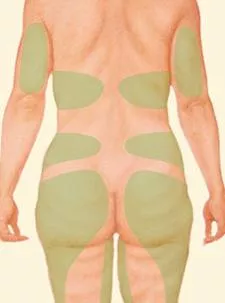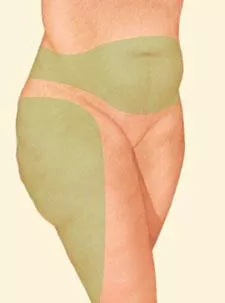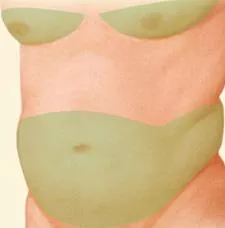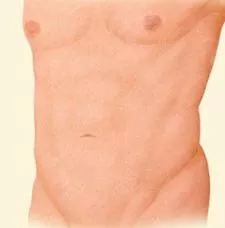Liposuction
Liposuction is a procedure that can help sculpt the body by removing unwanted fat from specific areas, including the abdomen, hips, buttocks, thighs, knees, upper arms, chin, cheeks, and neck. Liposuction is not a substitute for dieting and exercise, but it can remove stubborn areas of fat that don’t respond to weight-loss or working out. The procedure itself continues to be refined in order to provide selected patients with more precise results and sometimes quicker recovery times.
Though basic information is available at this site, information regarding your individual situation can only be provided by a physician, after examining you and listening to your concerns during a consultation.
The best candidates for liposuction
To be a good candidate for liposuction, you must have realistic expectations about what the procedure can do for you. It’s important to understand that liposuction can enhance your appearance and self confidence, but it won’t necessarily change your looks to match your ideal or cause other people to treat you differently. Before you decide to have surgery, think carefully about your expectations and discuss them with your surgeon.
The best candidates for liposuction are normal-weight people with firm, elastic skin who have pockets of excess fat in certain areas. You should be physically healthy, psychologically stable, and realistic in your expectations. Your age is not a major consideration; however, older patients may have diminished skin elasticity and may not achieve the same results as a younger patient with tighter skin.
Liposuction, like any surgical procedure, carries greater risk for individuals with medical problems such as diabetes, significant heart or lung disease, poor blood circulation, or those who have recently had surgery near the area to be contoured.








Planning your surgery
In your initial consultation, your surgeon will evaluate your health, determine where your fat deposits lie, and assess the condition of your skin. Your surgeon will explain the body-contouring methods that may be most appropriate for you. For example, if you believe you want liposuction in the abdominal area, you may learn that an abdominoplasty or tummy tuck may more effectively meet your goals.
Be frank in discussing your expectations with your surgeon. He or she should be equally frank with you, describing the procedure in detail and explaining its risks and limitations.
Getting the answers you need
Individuals considering liposuction often feel a bit overwhelmed by the number of options and techniques being promoted today. However, your plastic surgeon can help. In deciding which is the right treatment approach for you, your doctor will consider effectiveness, safety, cost, and appropriateness for your needs. This is called surgical judgment, a skill that is developed through surgical training and experience. Your doctor also uses this judgment to prevent complications; to handle unexpected occurrences during surgery; and to treat complications when they occur.
Your surgeon’s education and training have helped to form his or her surgical judgment, so take the time to do some background checking. Patients are encouraged to consider a doctor certified by the American Board of Plastic Surgery (ABPS). By choosing a plastic surgeon who is certified by the ABPS, a patient can be assured that the doctor has graduated from an accredited medical school and completed at least six years of additional training. To be certified by the ABPS, a doctor must also practice surgery for two years and pass comprehensive written and oral exams.
Preparing for your surgery
Your surgeon will give you specific instructions on how to prepare for surgery, including guidelines on eating and drinking, avoiding smoking, and taking or avoiding vitamins, iron tablets, and certain medications. If you develop a cold or an infection of any kind, especially a skin infection, your surgery may have to be postponed.
Also, while you are making preparations, be sure to arrange for someone to drive you home after the procedure and, if needed, to help you at home for a day or two.
Where your surgery will be performed
Liposuction will be performed in one of the operating rooms within the hospital. Most liposuction procedures are done on an outpatient basis for reasons of cost and convenience. However, if a large volume of fat will be removed, or if the liposuction is being performed in conjunction with other procedures, a stay in a hospital or overnight nursing facility may be required.
Anesthesia for liposuction
Various types of anesthesia can be used for liposuction procedures. If only a small amount of fat and a limited number of body sites are involved, liposuction is sometimes performed under local anesthesia, which numbs only the affected areas. More commonly, general anesthesia is utilized, however.
The surgery
The time required to perform liposuction may vary considerably, depending on the size of the area, the amount of fat being removed, the type of anesthesia, and the technique used.
In almost all cases, the “tumescent technique” is utilized where a medicated solution is injected into fatty areas before the fat is removed. The fluid—a mixture of intravenous salt solution and epinephrine (a drug that contracts blood vessels)—helps the fat be removed more easily, reduces blood loss, and also helps to reduce the amount of bruising after surgery. In cases where a general anesthetic is not utilized, a local anesthetic may be added to the solution as well. The amount of fluid that is injected varies depending on the location and the preference of the surgeon.
During the liposuction procedure, localized deposits of fat are removed to recontour one or more areas of the body. Tiny incisions are made, and a narrow tube or cannula is inserted and used to vacuum the fat layer that lies deep beneath the skin. The cannula is pushed and then pulled through the fat layer allowing the gradual removal of excess fat. The suction action is provided by a vacuum pump or a large syringe, depending on the procedure and surgeon’s preference.
Fluid is lost along with the fat, and it’s crucial that this fluid be replaced during the procedure to prevent shock when a significant amount of liposuction is carried out. For this reason, patients undergoing more extensive procedures need to be carefully monitored and receive intravenous fluids during and immediately after surgery.
All surgery carries some uncertainty and risk
Liposuction is normally safe as long as patients are carefully selected, the operating facility is properly equipped, and the physician is adequately trained.
It’s important to keep in mind that even though a well-trained surgeon and a state-of-the art facility can improve your chance of having a good result, there are no guarantees. Though they are rare, complications can and do occur. Risks increase if a greater number of areas are treated at the same time or if the operative sites are larger in size.
The scars from liposuction are small and strategically placed to be hidden from view. However, imperfections in the final appearance are not uncommon after lipoplasty. The skin surface may be irregular, asymmetric, or even baggy, especially in the older patient. Numbness and pigmentation changes may occur. Sometimes, additional surgery may be recommended.
After your surgery
After surgery, you will likely experience some fluid drainage from the incisions. Occasionally, a small drainage tube may be inserted beneath the skin for a couple of days to prevent fluid build-up. To control swelling and to help your skin better fit its new contours, you may be fitted with a snug elastic garment to wear over the treated area for a few weeks.
Don’t expect to look or feel great right after surgery. Even though modern techniques are believed to reduce some post-operative discomforts, you may still experience some pain, burning, swelling, bleeding, and temporary numbness. Pain can be controlled with medications prescribed by your surgeon, though you may still feel stiff and sore for a few days.
It is normal to feel a bit anxious or depressed in the days or weeks following surgery. However, this feeling will subside as you begin to look and feel better.
Getting back to normal
Healing is a gradual process. Your surgeon will probably tell you to start walking around as soon as possible to reduce swelling and to help prevent blood clots from forming in your legs. You will begin to feel better after about a week or two, and you should be back at work relatively quickly following your surgery. The stitches are removed or dissolve on their own within the first week to 10 days.
Activity that is more strenuous should be avoided for about a month as your body continues to heal. Although most of the bruising and swelling usually disappears within three weeks, a small amount of swelling may remain for six months or more.
Your surgeon will schedule follow-up visits to monitor your progress and to see if any additional procedures are needed.
If you have any unusual symptoms between visits—for example, heavy bleeding or a sudden increase in pain—or any questions about what you can and can’t do, call your doctor.
Your new look
You will see a noticeable difference in the shape of your body quite soon after surgery. However, improvement will become even more apparent after about four to six weeks, when most of the swelling has subsided. After about three months, any persistent mild swelling usually disappears and the final contour will be visible.
If your expectations are realistic, you will probably be very pleased with the results of your surgery. You may find that you are more comfortable in a wide variety of clothes and more at ease with your body. And, by eating a healthy diet and getting regular exercise, you can help to maintain your new shape.